Heading out the door? Read this article on the new Outside+ app available now on iOS devices for members! Download the app.
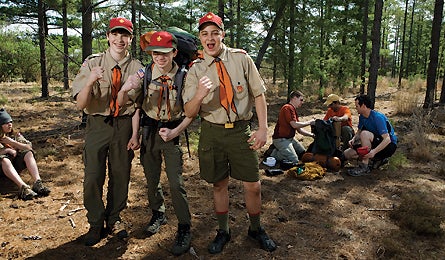
Michael, Todd, & Adam celebrate their pack loading win.
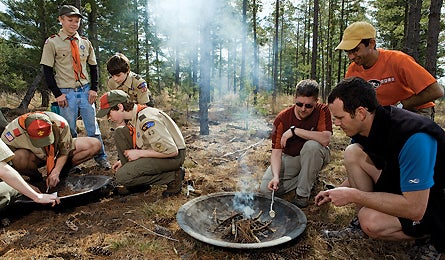
Team BACKPACKER takes 1st in fire starting.
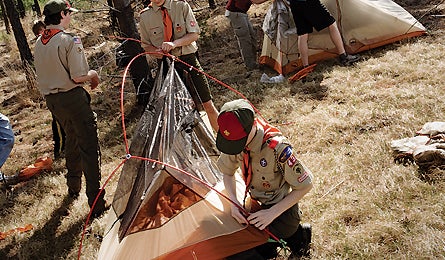
The tent pitching competition.
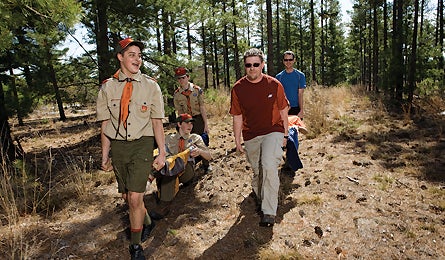
The Scouts run to a first-place first-aid win.
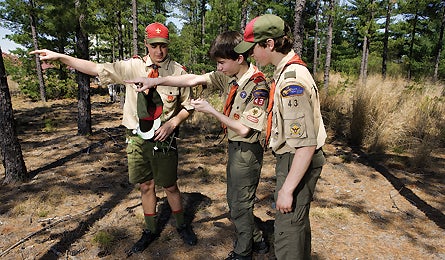
No bearing, no win for Troop 43.
Opponents: Troop 43 vs. Team BACKPACKER
TROOP 43: We recruited three scouts from a 40-member troop in Princeton, New Jersey, that spends 10 weekends in the woods each year; older members take a 50-mile backpacking trip each summer in New Hampshire’s White Mountains, Yellowstone, or Yosemite. The contenders–Todd Kelmar, 15, Adam Perez, 15, and Michael Treves, 14–have all reached Life-rank (that’s one step shy of Eagle) and acquired their camping merit badge.
TEAM BACKPACKER: We selected three readers with average hiking experience: David Mays, 35, a software engineer from Palmyra, New Jersey; Jeff Thompson, 29, owner of a window cleaning service in Philadelphia; and Louis Tevere, 42, an IT professional from Wyncote, Pennsylvania. Each camps between 10 and 20 nights a year.
Proving Grounds
The Pine Barrens of central New Jersey, at Lakehurst Naval Station
The Goal
Test outdoor know-how in 10 skills-based, head-to-head contests pulled straight from the pages of The Boy Scout Handbook:
BEAR BAGGING | FIRE STARTING | KNOT TYING | PACK LOADING AND FITTING | PACKING THE TEN ESSENTIALS| TENT PITCHING | COOKING FIRST AID | ORIENTEERING |FLAG FOLDING
The Prize
Our Golden Boot Award is a 19-inch-tall trophy of rugged beauty–in the form of a Cabela’s Laramie Peak Mid Hiker spray-painted in a lush gold-lamé shade.
Let the games begin
The teams gather on a warm, sunny day last spring, and after a few friendly hellos and pregame refreshments, things get testy. “It’s time to kick some Scout heinie,” taunts Jeff Thompson, the window cleaner from Philly.
“We’ll see about that, old man,” replies take-charge Adam.
“Got any more of those Cokes?” inquires a voice from the crowd that’s attached to a visibly overstimulated 11-year-old.
1. Bear Bagging
Game On
Each team gets a 50-foot section of nylon rope, a stuffsack containing 15 pounds of food–and no instructions. Ready, set, go. Team BACKPACKER dashes for a spindly pine. While Jeff knots one end of the rope to the sack, David ties off the other end to a chunk of wood. He sails the rope over a high branch. Louis and Jeff hold the sack aloft while David hoists it, then ties off the rope. Done in 2 minutes, 15 seconds.
Troop 43 has a rough start. Adam attempts to swing the heavy sack up and over a branch of a shrubby tree. Todd and Michael steal glances at the adults’ progress and pepper Adam with advice. “I told you we should have tossed a stick instead,” complains Michael, after the sack lodges in a tangle of lower branches. Two more attempts yield similarly dismal results. Six minutes later, the Scouts give up.
Winner
Team BACKPACKER takes it in a runaway. Readers: 1, Scouts: 0
By the Book
Bear bags should hang “at least 12 feet off the ground … and eight or more feet away from the trunks of trees,” says The Boy Scout Handbook. The accompanying illustration depicts stringing a bear bag between two trees, but offers no explanation on exactly how to do it. Try this: 1) Select a pair of branches 20 feet apart and at least 15 feet off the ground. 2) Tie one end of a rope to a tree trunk. 3) Throw the other end, weighted, over both branches in succession. 4) Tie a knotted loop (bight) in the cord midway between the branches. 5) Attach the bag to the loop with a knot or carabiner. 6) Pull on the unsecured end of the cord to lift the bag to the correct height and tie it off.
2. Firestarting
Game On
Each team receives a plastic garbage bag filled with assorted sticks ranging from pipe cleaner- to wrist-size, plus a firepan, magnesium firestarter, pocketknife, and a marshmallow. (Dirty trick: We soaked the wood with a hose.) Teams must gather tinder from the immediate vicinity. First team to brown the marshmallow wins.
The Scouts plunk a handful of dry pine needles in the center of their firepan. Adam shaves bits of the magnesium on top. Todd and Michael neatly stack their soaked firewood. The magnesium chips flash white-hot, but they quickly fizzle. The clock is ticking.
Meanwhile, Team BACKPACKER is already tending a flame. Like the Scouts, they used the pine needles as tinder–but with a crucial difference. “We scraped magnesium on the paper packaging the firestarter came in. Then fed the needles,” explains David. “Flamed right up.” Louis returns from the woods with a stick. At 4 minutes, 39 seconds he produces a perfect marshmallow: crispy on the outside, gooey on the inside.
Winner
Team BACKPACKER is twice as fast, with better results. Almost 10 minutes into the contest, the Scouts raise a flame and produce a charred marshmallow. Readers: 2, Scouts: 0
By the Book
Campfire success depends on tinder–the more flammable, the better. The Handbook advises mounding kindling atop loose tinder, arranging a tepee of small and medium-size fuel on top. Our add: Slice shavings of magnesium into a small pile, beneath loose tinder. When the tinder flames, add kindling.
3. Knot Tying
Game On
In this essential test, teams get a four-foot section of rope and instructions to tie a square knot, clove hitch, and bowline.
Winner
So much for a blowout. The Scouts whip out all three knots before Team BACKPACKER can even agree on what a square knot looks like. “Not my strength,” confesses Louis. Readers: 2, Scouts: 1
By the Book
If you can remember one knot, make it the bowline. It’s easy to tie, and doesn’t slip or jam under tension. To tie one, use the old mnemonic: The rabbit comes out of the hole, goes around the tree, and back down the hole.
4. Pack Loading and Fitting
Game On Each team gets a tent, sleeping bag, stove, fuel, clothing, and other equipment. Everything must go into an REI Passage 65 pack; then the team must adjust the pack to fit a team member.
“No, no, no. The tent goes toward the top, not down low,” Todd practically yells at the other Scouts. “Map in the top pocket!” insists Adam. Amid the arguing, tussling, and jamming of gear at close quarters, the teams resemble two rugby scrums.
Winner
Team BACKPACKER posts the faster time but loses on accuracy to Troop 43’s meticulous packing strategy. By stuffing its tent and food bag toward the top, Team BACKPACKER was top-heavy; Troop 43 hit the sweet spot with the center of gravity between the shoulder blades. As for fitting, both squads succeed at extending their harnesses to sit correctly on a teammate’s shoulders and hips, but the Scouts also win this contest by getting the center of gravity right (see below). Neither team deals with stove fuel correctly (seal it against leaks in a plastic bag, then tuck into a lower, exterior pocket). Readers: 2, Scouts: 2
By the Book
The Boy Scout Handbook offers tips on organizing gear in a backpack (“Arrange soft items so that they will cushion your back”), but is mum on weight distribution. Internal frame backpacks carry best when loaded with heavy items like food, water, and tent at shoulder height and close to your back. Lighter, bulky gear like cook kits and clothing go in the lower and middle of the pack. Your sleeping bag squishes into the bottom compartment.
5. Packing the 10 Essentials
Game On
From equal piles of assorted gear and clothing, each team must pull out The 10 Essentials–those butt-saving items no wilderness traveler should leave home without. To make it harder, we included toilet paper, a water filter, a spork, and other distractions.
Winner
Troop 43. The Scouts finished 30 seconds behind Team BACKPACKER but the youngsters got 9 out of 10 correct (they left out sun protection, which The Handbook cites–but is debatable). The seniors picked two incorrect items, including toilet paper. “It doubles as a firestarter,” argues David. Nice try. Readers: 2, Scouts: 3
By the Book
Exactly what constitutes the 10 emergency essentials is controversial. The Handbook lists a pocketknife, first-aid kit, extra clothing, raingear, water bottle, flashlight, trail food, matches and firestarter, sun protection, and map and compass. Other sources variously swap in a repair kit, space blanket, whistle, and garbage sack.
6. Tent Pitching
Game On
Each team gets a lightweight Big Agnes Copper Spur UL2 tent. First team to pitch theirs correctly wins. Team BACKPACKER goes right to work. Jeff snaps the hubbed poles into their I-shape configuration, while David lays out the tent body. Louis has the cross pole and rainfly ready.
The Scouts, meanwhile, fail to observe that the short end of the pole assembly aligns with the tent body. Once they get that sorted out, Todd is left holding the cross pole. “Where’s this go?” he asks. Nobody is sure.
Winner
Team BACKPACKER, no contest. In 2 minutes, 24 seconds, they pitch a drum-tight tent. At 4 minutes, 53 seconds, Team Scout stakes the last guyline. It’s all tied up as we enter the homestretch. Readers: 3, Scouts: 3
By the Book
Orient the tent with its lowest point into the wind; avoid setting up in a low-lying area where water could collect; drive stakes into the ground at an angle, with the tops pointing away from the shelter (fill stuffsacks with snow and bury them during the winter); and always guy out the rainfly tightly to increase stability and reduce unwanted condensation.
7. Cooking
Game On
Teams must prime and fire up an MSR SimmerLite stove, then cook an edible flapjack using pancake mix, shortening, and a nonstick frypan. The white-gas SimmerLite requires some know-how, and the Scouts properly pump the fuel bottle and insert the fuel line but cannot get fuel to flow. Minutes evaporate as Adam retries the same sequence without success. The Scouts’ frustration grows as they peek over at the adults. Instructions to the stove lay unopened beside them.
Winner
In 5 minutes, 24 seconds, Team BACKPACKER presents a lightly browned cake, ready for syrup. David examines the Scouts’ stove and identifies the problem. “You needed to snap this catch arm into place for the fuel to flow,” he says. Readers: 4, Scouts: 3
By the Book
Inexplicably, The Handbook relegates flapjacks to car-camping fare. But backpackers can make perfect pancakes using a nonstick pan like the MSR Flex Skillet.
8. First Aid
Game On
The scenario: a severely sprained ankle. The goal: treat the injury, improvise a stretcher out of assorted clothing and two long poles, and carry a teammate 15 yards across the finish line. Each squad wisely appoints its smallest member to play the victim, then tears into a first-aid kit and correctly selects an elastic bandage for an ankle wrap. Troop 43 quickly stabilizes Todd’s right ankle and scoots him onto a stretcher made of a rain jacket and hiking pants. They’re seconds ahead of Team BACKPACKER. In the race to the finish, Michael stumbles under the load and the older team almost closes the gap, but the Scouts make a youthful lunge for the finish line.
Winner
Troop 43, by a hair. Readers: 4, Scouts: 4
By the Book
Both teams correctly immobilized the victim’s ankle and built a sturdy stretcher by slipping poles through arm and leg holes in clothing. Typically hikers with sprains are able to walk out, which is always a better option than carrying someone. “If you suffer a sprain and must keep walking,” The Handbook advises, “don’t remove your shoe or boot.” That’s because swelling could prevent you from putting it back on, seriously hampering your ability to self-evacuate.
9. Orienteering
Game On
We created two equal-length courses in the forest, and planted three tacky- looking ornamental frogs along each one. The teams receive a compass and a course description–composed of the bearing and distance to each of their three frogs. The goal: find the frogs, gather them up, and return to the starting line as quickly as possible.
Winner
Team BACKPACKER simply took their bearing, spread out, and started running. “We knew one of us would find the frog ornament if we kept our bearing, so the exact distance was immaterial,” explains Jeff. Smart. They finish in less than two minutes. Meanwhile, the Scouts wander waaaay off track in a meadow while looking for the second frog. Troop 43 needs an assist from the judge to get back on course. Readers: 5, Scouts: 4.
By the Book
The Boy Scout Handbook gives clear instructions on taking and following a bearing. (Compass in hand, turn the compass housing until the direction of travel indicator matches the desired bearing. Then rotate the compass until the red needle points north. You’re oriented. Now sight along the direction of travel arrow, pick out a landmark, and walk toward it.) The Scouts were good up until they passed an old logging cable that moved the needle a few degrees. Not in The Handbook: Metal throws off a magnetic compass. (The disorienting effect is often caused by car hoods and belt buckles.)
10. Flag Folding
Game On
Okay, it’s hard to argue that flag folding is an essential outdoor skill. But with the adults leading by one–arguably because they had an advantage from using a wider range of more modern gear–it seems only fair to throw the Scouts a gimme.
Winner
The teens obviously know their way around a flag, but Team BACKPACKER smells victory and goes all out. The old guys’ folded Old Glory is a thing of beauty: a small, tight wedge of cloth that’s half the size of Troop 43’s flag and finished 20 seconds faster. “I had to fold the flag after weekly Scout meetings. I just never forgot how to do it,” explains David, the engineer. His admission throws the final score into doubt. Once a Scout, always a Scout?
In 1975, Jim Gorman earned Eagle Scout ranking with the very same Troop 43.